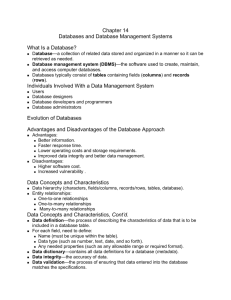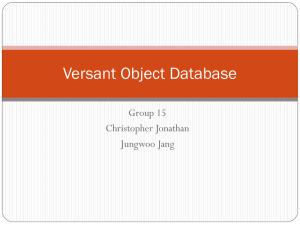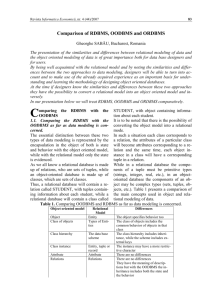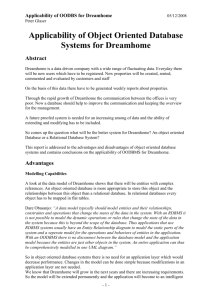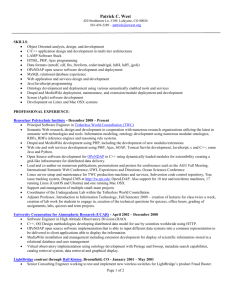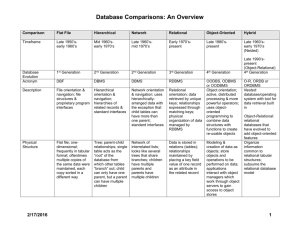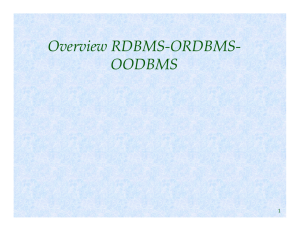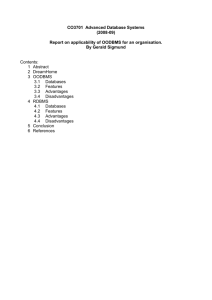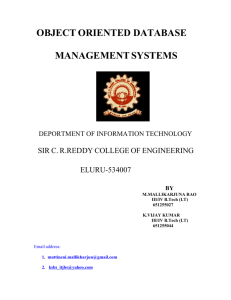Report on the applicability of an OODBMS for Dreamhome
advertisement
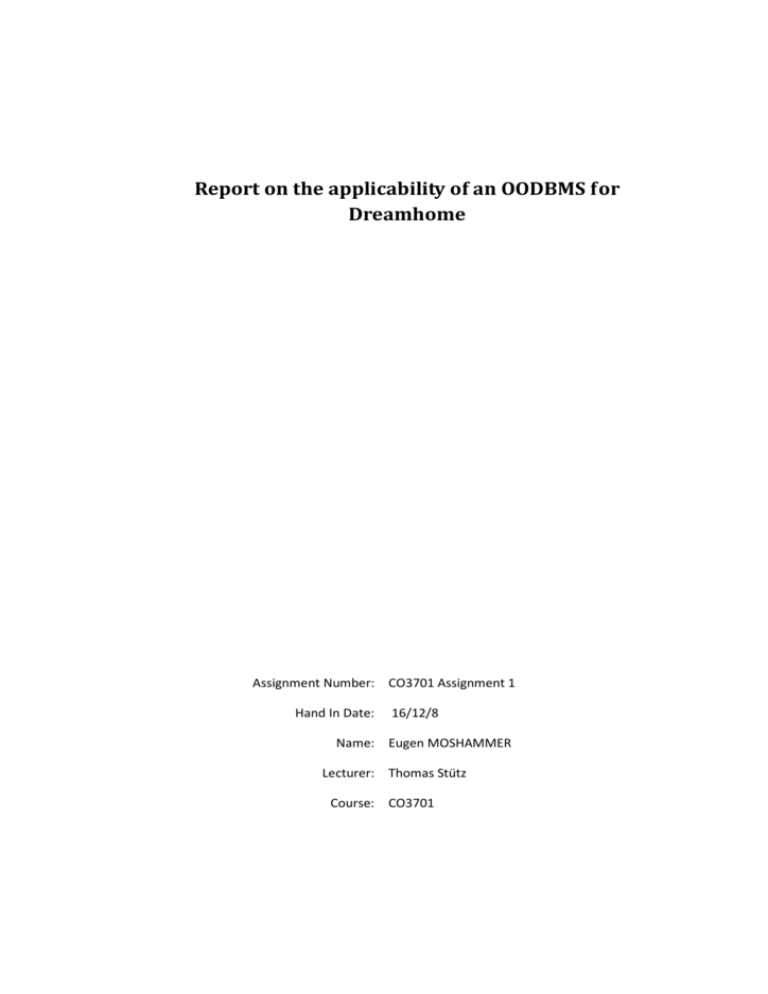
Report on the applicability of an OODBMS for Dreamhome Assignment Number: CO3701 Assignment 1 Hand In Date: 16/12/8 Name: Eugen MOSHAMMER Lecturer: Thomas Stütz Course: CO3701 Table of contents 1. Introduction.................................................................................................................................... 3 2. Object Oriented Database Management System (OODBMS) ........................................................ 3 3. Comparison of RDBMS with OODBMS ........................................................................................... 6 3.1. Related concepts.................................................................................................................... 6 3.2. Advantages and Disadvantages of OODBMS and RDBMS ..................................................... 7 4. Aspect of Hibernate with RDBMS................................................................................................... 9 5. Problem areas implementing an OODBMS within the organization............................................ 10 6. Conclusion .................................................................................................................................... 10 7. References .................................................................................................................................... 11 7.1. Figures.................................................................................................................................. 11 1. Introduction With the growing of Dreamhome company the administrative work also grows and now the company has a dimension that more and more administrative staff is being employed to manage the increasing paperwork. Another factor is, that the communication and information exchange between the offices are very low and so they need a shared location to store their data. So every office wants to store and retrieve the data of the whole company. In modern applications usually objects are used to represent data and there are different ways to persist the objects. Persistence implies a “process of how to store the objects” (Ambler, 1998) and for this process there are three main mechanisms: 1. Object Oriented Database Management Systems (OODBMS), 2. Relational Database Management Systems (RDBMS) and 3. Object-Relational Database Management Systems (ORDBMS). Well, another way to persist the objects is to write the object representation into a file but in praxis this mechanism of storing the data is never used nowadays. It is a standard situation for today’s applications that keep their data on a server in a database that they have to store some data at the same time as they get requests from multiple clients to show some data from the database. (Obasanjo, 2001) The goal of this assignment is to answer the following questions: What is an Object Oriented Database Management System in general? Is an Object Oriented Database Management System a real alternative to a Relation Database Management System? What are the advantages of using an Object Oriented Database Management System instead of a Relational Database Management System in general and especially for Dreamhome company? 2. Object Oriented Database Management System (OODBMS) At this point I will start with a definition what is an Object Oriented Database Management System: (Cattell et al, 2001) define “an ODBMS to be a DBMS that integrates database capabilities with object-oriented programming language capabilities” which means that an OODBMS is a combination of the capabilities of an object oriented programming language and the principals of a database management system. It includes the features of OO-programming like polymorphism, inheritance and encapsulation as well as the database properties like atomicity, consistency, isolation and durability (ACID). In such an ODBMS the object attributes and object methods are stored in the database. (Dogac et al, 1994) The Object Oriented Database Manifesto lists the following specifics for a system to support before it can be called an OODBMS: 1. “Complex objects 2. Object identity 3. Encapsulation 4. Types and Classes 5. Class or Type Hierarchies 6. Overriding, overloading and late binding 7. Computational completeness 8. Extensibility 9. Persistence 10. Secondary storage management 11. Concurrency 12. Recovery 13. Ad Hoc Query Facility” (Atkinson, 1989, pp. 223-240) A persistent object should belong to a class and can have one or more types and attributes. Each object has an explicit object identifier (OID). OIDs are permanent, not based on any data of the object or the object class and generated by the system, so it is secured that no object can have the same object identifier like another object. The Object identification is the reason why persisting object references are possible. This mechanism makes it easy to store objects to the database with all their reference objects at the same time. But the other side of the coin is that it could be the reason for referential integrity problems if an object is deleted while other objects still have references to the first one. Figure 1 shows on the one hand how the objects are stored in the object oriented database and on the other hand, how the objects are represented in the application cache. figure 1: Example for object structure in application and OODBMS One of the primary features of an Object Oriented Database Management System is that there is no difference in the access to the objects if they are stored in the database or in the memory. This fact is a significant difference to RDBMS because in OODBMS there is no need to interact via a sub language like SQL and there is also no reason to use a Call Level Interface like ODBC, ADO or JDBC. There are two ways of accessing to an object from the database. If a client do a request to an object from the database it will be loaded to the application’s cache where it can be used as a transient value without connection to the representation of the object in the database. It also can be a mirror to the stored objects and in this case the changes will be reflected to the database objects and changes of the database objects will be refetched from the OODBMS. 3. Comparison of RDBMS with OODBMS Choosing between these options need to have a closer look at some different aspects. The main keywords are development, performance and access to different sources (it’s possible that more than one application needs the same data source). The last one is a necessary point for Dreamhome company, because all the different offices can have different applications and need the data from the same database. The performance of the Database it concerned on the structure of the data. An application that navigates though the data like following links will be more efficient if it uses an Object oriented DB. If you have to process the data sequentially or have a complex query to get the data the relational DB is faster. So in fact the data structure of the Dreamhome company will not be extremely complex because in the shared database there will be some information about the owner, the clients, the properties they want to rent, the furniture and the services the owners and clients want to occupy. (Zyl, 2006) Another possibility is a combination of the two solutions but some experts belief that these objectrelational tools add translation overhead at each operation to the database and so this combination is slower than each single solution on its own. (Zyl, 2006) (Hibernate is a example for such an objectrelational tool, but there will be more information about this issue in an own paragraph in this paper) So it is possible that to develop with a more powerful OO domain modeling technique, “whose constructs are then translated to relational equivalents by the tool”. (Zyl, 2006) Related concepts Some basic concepts of the relational database model are much related to those of object oriented database model. A class in the OODBMS is analog to the relation or table of an RDBMS. An instance of a class is similar to a tuple in the relational database with the difference that a class has attributes and behaviors. A class attribute is similar to a column in a tuple except that a class attribute can hold data of many types and a column can hold only primitive data types. The last point is that classes have methods that are complete; relational databases normally do not have complete programming capabilities. Stored procedural languages come close to those programming features. (Obasanjo, 2001) Indexes, deadlock detection, backup and restoration are features that are normal day-to-day business for a relational database management system but these mechanisms also exist in the OODBMS. In the following part there is a list and a description of advantages and disadvantages of Object Oriented Database Management Systems partly compared with relational database management systems. (Obasanjo, 2001) 3.2. Advantages and Disadvantages of OODBMS and RDBMS Most OODBMSes have implemented a reachability persistence which is a big advantage at complex data relationship especially complex object relationship (e.g. networked data structure). Reachability persistence means that if an object is stored to the database, the object references the first one is also stored. (If Object A references Object B, and Object A is persistent, Object B is also persistent) (Edlich, Paterson et al, 2006) The depth of the reachability persistence can be specified by the programmer, so whole bundles of objects can be fetched with a single call. The details like references between the stored objects are handled by the Management system. Such object structures can be found at a tree with parent, child, grandchild and so on. In this situation there is no need to change the original structure of the data to a model. Programmers only have to specify the depth of the persistence and so they can control if the whole tree is fetched and stored or only a few branches with children. There is also no problem to store an object which contains a collection of other objects of different types. Most of the ODBMSes treat the collection just like another object and allow fetching and storing the parent object with all the members in it with a single call. But not only the relationship of the data can be very complex, also the data itself can have a very complex structure. It is not unusual that you have a big class which holds a number of medium-sized classes which themselves holds a lot of small-sized classes. In a relational database model either you have a big table with many null entries or you have many small tables which are linked with foreign keys. The problem is if you have very many small tables and you need the data from all of it you always have to do a join over the tables which costs lot of time in some cases. (Grehan, 2005a) The data has usually a hierarchical form while modeling a real world problem. This is also the situation in Dreamhome company. For instance the supervisor and assistant situation can be build much easier in an OODBMS than in a RDBMS. In an RDBMS you either have a field that identifies the supervisor or you have a second table with a foreign key to identify the relationship between supervisor and assistant. In an OODBMS you simply have a class Assistant which is parent class of the class Supervisor. Inheritance is a standard feature which supports every object oriented programming language and allows that a child object inherits the behavior and attributes from the parent object. So it is also supported by Object Oriented Database Management Systems which means that if a class A is derived from a class B than all methods and attributes of class B can be used everywhere where class A is used. (Obasanjo, 2001) If there are some classes whose members are collections (e.g. a List or a Set) this represents a one to many relationship in a RDBMS. So there is a need of two tables. One for the first object and a second one which stores the collection defined in the parent object. This technique implies a work overhead. This situation is much more difficult if the parent object contains different types of objects. Hibernate is a solution for this problem. (Grehan, 2005a) Another feature of object oriented languages and databases is polymorthism. “In simple terms, polymorphism is the ability of one type, A, to appear as and be used like another type, B. In strongly typed languages, this usually means that type A somehow derives from type B, or type A implements an interface that represents type B.” (en.wikipedia.org, 22/11/8) A change of the structure of data and objects on the fly is not a problem with an Object Oriented Database Management System. The longer one application lives the higher is the probability that some changes of the data / object structure are necessary. If the situation occurs that a field have to be added to the structure, the Mangement system handles it to add the field to the old objects which are already stored and fills it with default values like null or zero. If a field has to be removed from the object the OODBMS loads the whole object and skip the fields which are not available any more. This is a big disadvantage in an RDBMS because if some data members or relationship between objects change there is also a change of the schema and query code needed and the update of the old data is very work intensive. (Grehan, 2005a) Dreamhome company have several offices around the world. Resultant on this fact there are many applications using the same database and the access to the data are the same from each application in an OODBMS because objects being fetched, stored and manipulated in the same way. And a change of the class structure is one change of a single library. Most applications are using object oriented programming techniques and if a relational Database Management System is in use there have to be a translation from the object model to the relational model. So, in Dreamhome company each application has a schema / mapping code, and if there is a change of structure of the database, all applications have to be searched through and changed. (Papazoglou, 2000) But an ODBMS is not always the better way to store data. There are also some disadvantages of Object Oriented Database Management Systems. The extraction of the data, for instance for some reports, are very complicated because Object databases generally hide their contents behind object oriented programming environments, so special tools have to be used to extract the data. (Zyl, 2006) The next point is that normally there is a language dependency in OODBMSes. This means that the database is usually linked to a specific language and the data in the system are only accessible from this language using a specific Application Programming Interface (API). (Obasanjo, 2001) There is one more point which has to be note as a disadvantage of OODBMS: the lost of flexibility. In relational database systems it is no problem to do ad hoc queries. In such queries it is the possibility exists to create new tables by joining already existing tables. But it is not possible to “join” two classes in an OODBMS. An Object Oriented Database Management system highly depends on the design of the system. (Obasanjo, 2001) A Relational Database Management System, named in some points before, is an alternative to the OODBMS. “Relational databases store data in tables that are two dimensional. The tables have rows and columns. Relational database tables are "normalized" so data is not repeated more often than necessary. All table columns depend on a primary key (a unique value in the column) to identify the column. Once the specific column is identified, data from one or more rows associated with that column may be obtained or changed.” (www.comptechdoc.org, accessed 23/11/8) The issue of complex data relationship, before named as an advantage in OODBM Systems, is a disadvantage of RDBMS. In situations where a deep object structure is given like a tree with many twigs and leafs it is a very time intensive and difficult exercise to translate the highly connected object structure to a form which can be fit into a relational database. (Grehan, 2005a) On the one hand it is very difficult to wrap the data to the relational tables and on the other hand the original structure is lost. So there is a large section of code needed to wrap the data in the transactions and to safeguard the data relation. Another point is that this overhead impedes performance in multiuser applications. The above named fact is only for the sake of completeness. For the Dreamhome company this point doesn’t have much relevance because there is no really high complex object structure given. But there are also some points which argue for a Relational Database Management System. It is a fact that the efficiency of a RDBMS is higher when the data and the relationship between the data are simple. Another fact is that the Standards for RDBMS are more stable than for an ODBMS and there are much more user tools available for RDBMS. 4. Aspect of Hibernate with RDBMS Another possibility which have to be note is a combination of a relational database system with an object relational mapping tool like Hibernate. “Hibernate is an object-relational mapping (ORM) library for the Java language, providing a framework for mapping an object-oriented domain model to a traditional relational database. Hibernate solves Object-Relational impedance mismatch problems by replacing direct persistencerelated database accesses with high-level object handling functions.” (en.wikipedia.org, accessed 23/11/8) Hibernate is a middleware between the object oriented programming language and the relational database system and covers the transformation from an object to the relational form which can be stored into the database, also if the object contains a list or a set of other objects. (Bauer, King, 2004) 5. Problem areas implementing an OODBMS within the organization New applications have to be implemented, which can store and fetch the data into and from the OODBMS which may include some extra costs for Dreamhome company. Another possibility is to search for free standard tools which can handle the data exchange with the Object Oriented Database Management System. 6. Conclusion Nowadays most of the applications connected to a database use the relational standard but recently the Object Oriented Database Management System becomes more important and it is expected that many companies like Dreamhome research the advantages of OODBMS and implement this solution. 7. References Rick Grehan, When to Use an ODBMS, 2005a Rick Grehan, ODBMS for RDBMS users, 2005b Pieter van Zyl, Derrick G. Kourie, Andrew Boake, Comparing the Performance of Object Databases and ORM Tools, ESPRESSO Research Group Department of Computer Science University of Pretoria, 2006 Stefan Edlich, Jim Paterson et al, The Definitive Guide to db4o, Chapter 3 – Comparing the Object and Relational Data Models, Apress, 2006, ISBN 1-59059-656-0 Dare Obasanjo, An Exploration of Object Oriented Database Management Systems, 2001 (http://www.25hoursaday.com/WhyArentYouUsingAnOODBMS.html, accessed 10/11/8) OODBMS Facts. Barry & Associates. 2001 (http://www.odbmsfacts.com/ accessed 28/10/8) Atkinson M. et al., The Object-Oriented Database Manifesto. In Proceedings of the First International Conference on Deductive and Object-Oriented Databases, pages 223-40, Kyoto, Japan, December 1989 ( http://www.cs.cmu.edu/People/clamen/OODBMS/Manifesto/htManifesto/Manifesto.html accessed 30/10/8) McFarland, Gregory, Andres Rudmik, and David Lange, Object-Oriented Database Management Systems Revisited. 1999 (http://www.dacs.dtic.mil/techs/oodbms2/ accessed 1/11/8) Object-oriented database articles and products (http://www.service-architecture.com/object-oriented-databases/ accessed 16/11/8) Basic principals of building object oriented databases (http://www.garret.ru/oodbms.html, accessed 4/11/8) Papazoglou M.P., Spaccapietra S., Tari Z. (2000) Advances in Object-Oriented Data Modeling, MIT Press Dogac A., Ozsu T.M., Biliris A. (1994), Advances in Object-Oriented Database Systems, Turkey: Birkhäuser (1994) Bauer C., King G. (2004) Hibernate in Action. Practical Object/Relational Mapping, Manning Hibernate (http://en.wikipedia.org/wiki/Hibernate_(Java) accessed 23/11/8) Object Oriented Databases (http://www.comptechdoc.org/independent/database/basicdb/dataobject.html accessed 23/11/8) Polymorphism in object-oriented programming (http://en.wikipedia.org/wiki/Polymorphism_in_object-oriented_programming accessed 22/11/8) 7.1. Figures figure 1: Example for object structure in application and OODBMS: http://www.servicearchitecture.com/images/object-oriented_databases/object-database.jpg accessed on 2008-11-1
